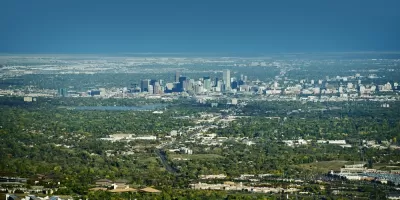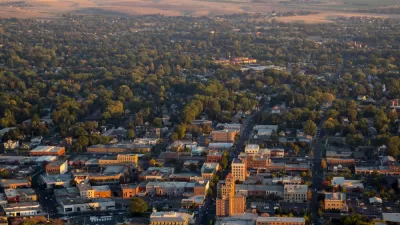Douglas County’s master plan indicates that areas south of current development will likely remain preserved through conservation initiatives, but the metro area’s booming population indicates that growth will continue to happen, somewhere.

The Denver metropolitan area has a new southern growth boundary, at least for a while, reports John Aguilar for the Denver Post. According to Aguilar, Douglas County’s master plan shows no urban development south of the town of Larkspur, “And if it ever does, it will be largely hemmed in by large swaths of land protected by conservation easements and preservation designations — the result of the purchasing power of Douglas County’s nearly 30-year-old open space sales and use tax.” In November, voters will weigh in on a 15-year extension for the tax.
However, Aguilar points out that the natural buffer created by the Douglas County plan doesn’t bar all future urban sprawl in the area, whose population has been exploding in recent years and is projected to keep growing. “The metro area as a whole, which has just over 3.2 million people now, will grow to just under 4 million in the next 18 years, according to the state demographer’s office,” more than double the 1990 population of 1.8 million. Development is booming in the north and east sides of the Denver area, limited primarily by the West’s growing water shortage and in part by the region’s geography.
FULL STORY: Metro Denver’s growing sprawl now has a hard southern boundary

Alabama: Trump Terminates Settlements for Black Communities Harmed By Raw Sewage
Trump deemed the landmark civil rights agreement “illegal DEI and environmental justice policy.”

Study: Maui’s Plan to Convert Vacation Rentals to Long-Term Housing Could Cause Nearly $1 Billion Economic Loss
The plan would reduce visitor accommodation by 25% resulting in 1,900 jobs lost.

Planetizen Federal Action Tracker
A weekly monitor of how Trump’s orders and actions are impacting planners and planning in America.

Wind Energy on the Rise Despite Federal Policy Reversal
The Trump administration is revoking federal support for renewable energy, but demand for new projects continues unabated.

Passengers Flock to Caltrain After Electrification
The new electric trains are running faster and more reliably, leading to strong ridership growth on the Bay Area rail system.

Texas Churches Rally Behind ‘Yes in God’s Back Yard’ Legislation
Religious leaders want the state to reduce zoning regulations to streamline leasing church-owned land to housing developers.
Urban Design for Planners 1: Software Tools
This six-course series explores essential urban design concepts using open source software and equips planners with the tools they need to participate fully in the urban design process.
Planning for Universal Design
Learn the tools for implementing Universal Design in planning regulations.
Caltrans
Smith Gee Studio
Institute for Housing and Urban Development Studies (IHS)
City of Grandview
Harvard GSD Executive Education
Toledo-Lucas County Plan Commissions
Salt Lake City
NYU Wagner Graduate School of Public Service





























